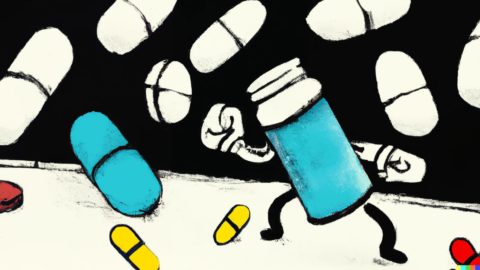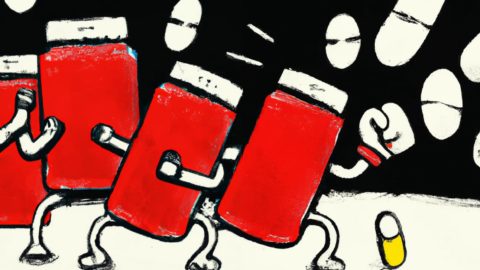If you want to search Cost Curve back issues or link to anything you read here, the web links and archive are online at costcurve.beehiiv.com. You can subscribe there, too.
INFLECTION POINT/ New Data Shows How the IRA Dents NPV, Derailing Development at an Early Stage
Much of the attention around IRA price controls is focused on super-tangible numbers: How much will be saved next year? How much lower will sales of drug X be in two years? What kind of dent will that leave in company Y’s revenue?
These are not unimportant questions, but they don’t get to the more profound question of what price controls might do to earlier-stage innovation. The idea is that at every stage of a medicine’s development, it has a value that incorporates both future revenues as well as all the development risks. That’s all baked into a measure called net present value, or NPV.
If the risks outweigh the revenue, the NPV goes negative, and a drug doesn’t get developed. Changing either side of this equation changes the NPV.
So early-stage investors and drug developers have to ask the question of what happens to NPV to early-stage assets in an era of “negotiation.”
The answer to that question is not encouraging, per a new peer-reviewed paper from the folks at RA Capital. It’s worth sitting with. But if you are caffeinated and must rush, the RApport blog has a great summary.
They took a theoretical small-molecule drug that would otherwise be considered a “blockbuster” success story and looked at how the NPV of that molecule would be affected at various timepoints in its development.
The upshot is that, sure, a medicine that looks good at approval or in Phase 3 would have a positive NPV, even with price controls. But that medicine doesn’t emerge, fully-formed, in Phase 3 trials.
Looking at earlier timepoints, the revenue impact of price controls would dent the NPV in such a way that the medicines just wouldn’t get developed in the first place.
The chart below sketches out what that would look like. Caveats abound here: The RA team looked at a drug targeted to the Medicare population, and small changes in assumptions might change a negative NPV into a more promising investment. But — regardless — it’s a reminder that a lot of early-stage programs sit on a razor’s edge.
If you want to play with the model, the RA team open-sourced it.
QUICK TURNS/ Two Pharm-to-Table Updates, and Tariffs Still Loom
An update on yesterday’s “phony pharm to table” story: I didn’t realize, when I told the story of how Hims & Hers had tried to position itself as a destination for the Zepbound-curious, what happened the company’s stock. Hims jumped more than 10% on the news, though the Lilly clarification of what’s really going on erased all that gain (and then some).
Another incremental pharm to table story: knownwell is now in the stable of telehealth providers for LIllyDirect’s obesity offering. More curation.
The extensive tariffs announced yesterday specifically exempt pharmaceuticals. But the assumption seems to be that the industry’s turn is coming, as detailed well by Bloomberg this morning. If you were wondering if biotech investors were cheering the lack of mention yesterday, I have some bad news for you:
A couple of weeks ago, there were rumblings that the wanton firings of FTC commissioners might derail the agency’s lawsuit against the PBMs. Yesterday came the news that — yup — there are currently zero commissioners available to oversee the lawsuit, so the effort is now on hold. This would be a scandal at any other point in history, but it’s 2025, so I’m not sure this is registering.
Adam Feuerstein at STAT has a nice review of the industry’s reputational issues and the need to go after international freeloading, filtered through the lens of a CNBC interview with Regeneron CEO Len Schleifer. But I have to be honest here: No one has nailed the policy solutions for how to get Europe to pay its fair share.
Some 340B bits: Fitch, the credit rating agency, said that nonprofit hospitals had a much better 2024 than their 2023, in part because of rising revenues. Could it be … 340B? And good news! More pharmacies are opening! Could it be … 340B? In all seriousness, the hospitals-opening-340B-pharmacies is a great feature story for an enterprising health policy reporter (once, you know, all the other chaos subsides).
Everyone is excited for Robert Kennedy Jr. to show up at a Senate HELP committee meeting next week.
Today’s lol: Here is a video of Patrick Conway, the CEO of Optum Rx, telling attendees at yesterday’s Politco Health Care Summit that Optum Rx isn’t really a PBM. “I don’t think of us as a PBM at Optum Rx. … As a team, we’re a pharmacy care services organization. In fact, over half of our business, about half of our business now is the pharmacy side, and it’s growing.” Make of that what you will.
Cost Curve is produced by Reid Strategic, a consultancy that helps companies and organizations in life sciences communicate more clearly and more loudly about issues of value, access, and pricing. We offer a range of services, from strategic planning to tactical execution, designed to shatter the complexity that hampers constructive conversations.
To learn more about how Reid Strategic can help you, email Brian Reid at brian@reidstrategic.com.





